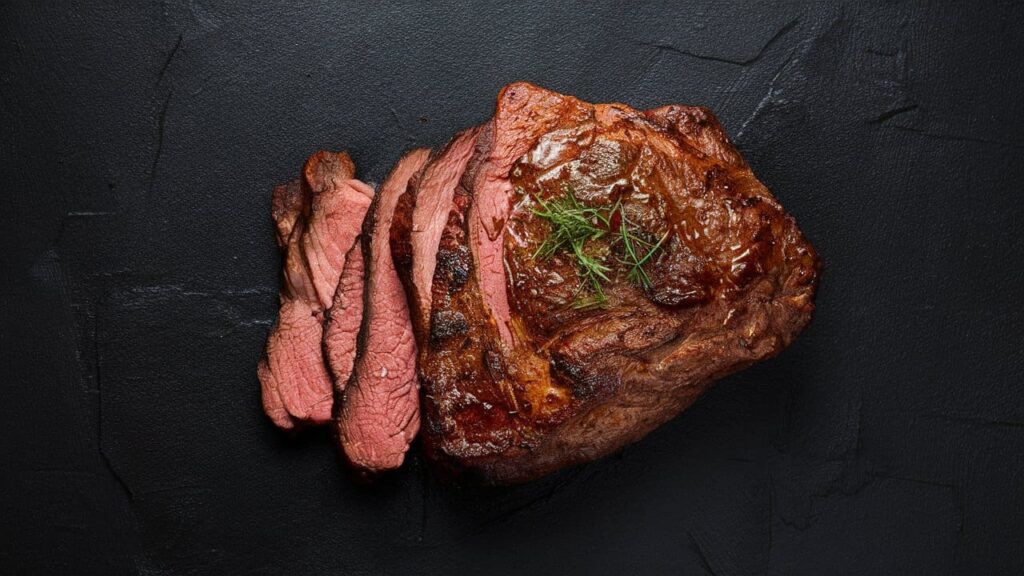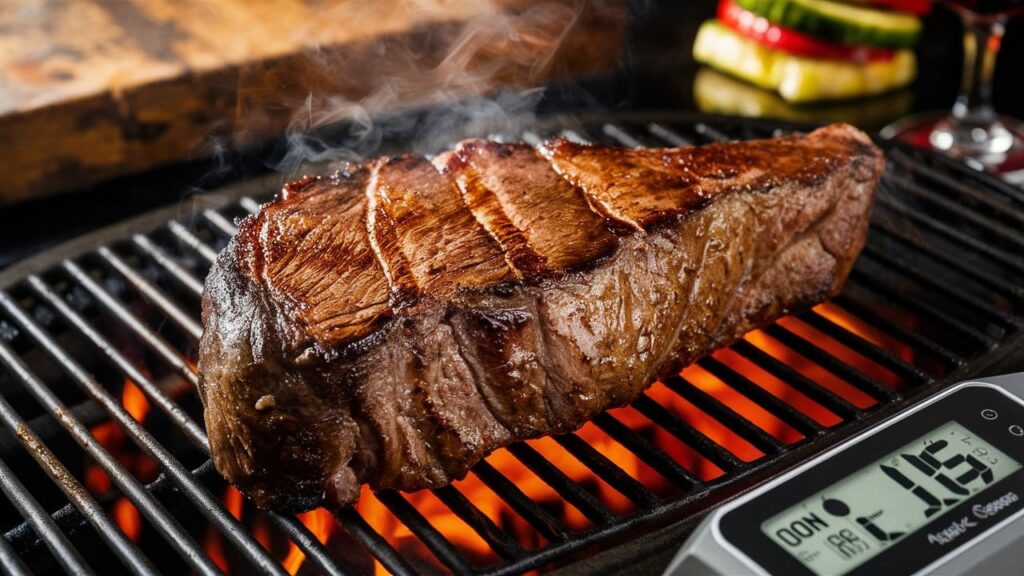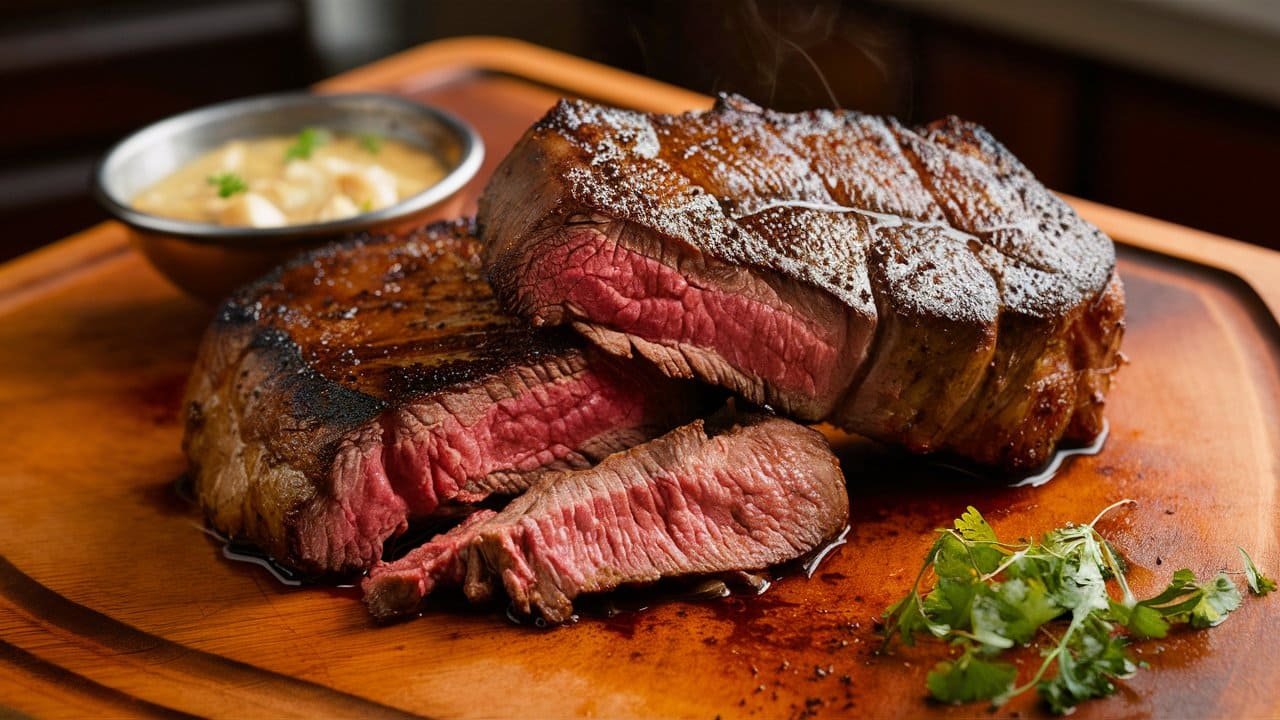Understanding how cooking time affects the tenderness of tri-tip is crucial for anyone looking to master this popular cut of beef. Tri-tip, known for its rich flavor and versatility, can be a bit tricky when it comes to achieving the perfect texture. This article explores whether cooking tri-tip for a longer period results in a more tender meat, alongside methods and tips to optimize cooking outcomes.
Understanding Tri-Tip
Characteristics of Tri-Tip
It is leaner than some other cuts but known for its rich flavor. Understanding the grain of the meat and its fat content is essential for cooking it properly, as these factors influence how tender the meat will be after cooking.
Common Cooking Methods
Tri-tip can be cooked in various ways, including grilling, roasting, and slow cooking. Each method can affect the texture and tenderness of the meat differently, making it important to choose the right cooking technique based on the desired outcome.
Importance of Meat Preparation
Proper preparation before cooking can significantly affect the tenderness of tri-tip. This includes marinating the meat to tenderize it and bringing it to room temperature before cooking to ensure even heat distribution.
Cooking Tri-Tip to Maximize Tenderness
Grilling Tri-Tip
Grilling is a popular method for cooking tri-tip due to the flavor that the high heat and smoke impart to the meat.
- To achieve tenderness when grilling, it is crucial not to overcook the tri-tip. Cooking it to medium-rare or medium, typically to an internal temperature of about 135°F to 145°F, allows the meat to retain moisture and tenderness.
Roasting Tri-Tip
Roasting in an oven is another effective way to cook tri-tip, especially when aiming for a slightly more controlled cooking environment.
- Slow-roasting at a lower temperature can help the tri-tip become more tender. Using a meat thermometer to monitor its internal temperature closely ensures that it does not overcook.
Slow Cooking Tri-Tip
Slow cooking is well-suited for making tougher cuts of meat tender and juicy.
- Cooking tri-tip slowly at a low temperature for several hours can break down the connective tissues without drying out the meat, resulting in a tender texture. This method is particularly effective when the tri-tip is submerged in a liquid, such as a broth or marinade.
The Science Behind Meat Tenderness
Connective Tissue and Collagen
Tri-tip contains connective tissues that are made up of collagen, which can make the meat tough. However, when cooked slowly at low temperatures, collagen transforms into gelatin, which is a key factor in making the meat tender.
Effects of Cooking Temperature
The temperature at which tri-tip is cooked can significantly affect its texture. High temperatures can cause the proteins in the meat to contract and squeeze out moisture, leading to tougher meat. Conversely, lower temperatures allow for a gentler cook, preserving moisture and breaking down connective tissues more effectively.
Time as a Factor
While longer cooking times at low temperatures can help in tenderizing tri-tip, there is a balance to be struck. Overcooking can lead to dryness, even if the meat becomes softer. Thus, it is important to find the right duration for cooking tri-tip based on the cooking method and the size of the cut.
Best Practices for Preparing and Cooking Tri-Tip
To ensure the tenderness and flavor of tri-tip are maximized, certain preparation and cooking techniques should be employed. This section outlines the best practices for marinating, seasoning, and cooking tri-tip, providing valuable insights to help you achieve the best results.
Marinating Tri-Tip
Benefits of Marination
Marinating tri-tip can significantly enhance its tenderness and flavor. The acids in marinades, such as vinegar, lemon juice, or wine, help break down tough muscle fibers and collagen, making the meat softer and more palatable.
Effective Marinade Ingredients
- Acids: Vinegar, citrus juice, or wine are essential for breaking down tough proteins.
- Oils: Olive or canola oil helps keep the meat moist and carry flavors deeper into the meat.
- Herbs and Spices: Garlic, rosemary, thyme, and pepper add depth and complexity to the flavor profile of the meat.
Marination Time
For optimal results, tri-tip should be marinated for at least 4 hours, though overnight marination is often recommended for maximum tenderization and flavor infusion. However, marinating for too long, especially in a highly acidic marinade, can cause the meat fibers to break down too much, resulting in a mushy texture.
Seasoning Tri-Tip
Choosing the Right Seasonings
Select seasonings that complement the rich, beefy flavor of tri-tip without overpowering it. Simple salt and pepper work well, but adding spices like paprika, onion powder, and a touch of cayenne can enhance the taste.
When to Season
Apply dry seasonings at least 30 minutes before cooking, which allows the salt and spices to penetrate the surface, improving the meat’s flavor and helping to retain its juices.
Using Rubs
Creating a dry rub with a mixture of salt, pepper, garlic powder, and your chosen spices can create a delicious crust on the tri-tip when cooked at high temperatures, adding both texture and flavor.
Cooking Techniques for Optimal Tenderness
Grilling Techniques
- Preheat the Grill: Ensure your grill is hot before adding the tri-tip, which should sizzle on contact.
- Direct and Indirect Heat: Start by searing the tri-tip over direct heat to form a crust, then move it to a cooler part of the grill to finish cooking without charring.
Roasting Techniques
- Oven Temperature: Preheat your oven to 325°F (about 163°C) for a slow roast that allows the tri-tip to cook evenly.
- Use of Thermometer: To prevent overcooking, use a meat thermometer to monitor the internal temperature, pulling the meat out of the oven when it reaches 5 degrees below your desired doneness since it will continue to cook while resting.
Slow Cooking Techniques
- Low and Slow: Set your slow cooker or oven at a low temperature (around 200°F or 93°C) and allow several hours for the tri-tip to cook gently.
- Adding Liquids: Incorporate a small amount of stock or a flavorful liquid to enhance moisture retention and add flavor.

Troubleshooting Common Cooking Issues with Tri-Tip
Cooking tri-tip can sometimes present challenges, even for experienced cooks. Understanding how to address common issues will help ensure that your tri-tip turns out tender and flavorful every time. This section focuses on identifying and rectifying typical problems encountered when cooking this unique cut of beef.
Identifying Common Cooking Mistakes
Overcooking
Tri-tip can become tough and dry if cooked beyond the recommended internal temperatures.
- Solution: Use a meat thermometer to closely monitor the internal temperature. Remove the tri-tip from the heat source when it is 5-10°F below the target temperature, as it will continue to cook while resting.
Undercooking
While some diners prefer their tri-tip more on the rare side, undercooking can be problematic, especially for those who prefer their meat more done.
- Solution: Ensure that all parts of the tri-tip reach at least 135°F for medium-rare. Allow the meat to rest after cooking, which helps the juices redistribute and the residual heat to finish the cooking process.
Uneven Cooking
Due to its irregular shape, tri-tip can sometimes cook unevenly, with thinner parts becoming overcooked while thicker parts are underdone.
- Solution: Consider butterflying the thicker part of the tri-tip to create a more uniform thickness. Alternatively, use a two-zone cooking method on the grill or in the oven, moving the meat from higher to lower heat as necessary.
Advanced Cooking Techniques to Enhance Tenderness
Reverse Searing
This method involves slowly cooking the tri-tip in a low-temperature environment before finishing it with a high-heat sear.
- Benefits: Reverse searing allows for more even cooking and better moisture retention, resulting in a juicier, more tender tri-tip.
- How to Implement: Cook the tri-tip in an oven set to about 225°F until it reaches an internal temperature of about 10°F below your desired doneness. Then, sear it on a hot grill or skillet for a couple of minutes on each side to develop a flavorful crust.
Resting the Meat Properly
Allowing the tri-tip to rest after cooking is crucial for maintaining its juiciness.
- Benefits: Resting allows the juices to redistribute throughout the meat, rather than running out onto the cutting board when sliced.
- Best Practices: Tent the tri-tip with foil and let it rest for at least 10 minutes before slicing. Slice against the grain for maximum tenderness.
Using a Marinade Injector
For an extra boost of flavor and moisture, consider using a marinade injector to introduce a marinade directly into the interior of the tri-tip.
- Benefits: This can enhance the flavor and tenderness of the meat, especially in thicker cuts.
- Recommended Marinades: Use a marinade that complements beef, such as a mixture of olive oil, garlic, herbs, and a touch of acid like vinegar or lemon juice.
Creative Serving Suggestions for Tri-Tip
Once you have mastered the art of cooking tri-tip, the next step is to serve it in a way that enhances its flavor and caters to the tastes of your guests. This section offers creative serving suggestions and presentation tips to make your tri-tip the star of any meal.
Transforming Tri-Tip into Main Courses
Tri-Tip Steak Dinners
Serve slices of tri-tip as the centerpiece of a traditional steak dinner. Pair with classic sides such as garlic mashed potatoes, sautéed vegetables, or a fresh garden salad.
- Wine Pairing: Complement the rich flavors of the tri-tip with a robust red wine like Cabernet Sauvignon or a smooth Malbec.
Tri-Tip Sandwiches
Tri-tip makes for a delicious sandwich filling, especially when topped with caramelized onions, melted cheese, and a tangy barbecue sauce or aioli. Serve on toasted ciabatta or sourdough bread for a satisfying meal.
- Additional Toppings: Consider adding arugula, sautéed mushrooms, or roasted bell peppers for extra flavor and texture.
Tri-Tip Tacos
Slice or shred the tri-tip and use it as a filling for tacos. Complement the meat with avocado slices, diced onions, cilantro, and a squeeze of lime.
- Salsa Options: Enhance the tacos with homemade salsa verde or a chunky tomato salsa for a fresh, vibrant addition.
Appetizers and Small Plates
Tri-Tip Sliders
Create mini sliders using small buns, slices of tri-tip, and your choice of sauce. These are perfect for parties and social gatherings as they are easy to eat and can be prepared in advance.
- Sauce Suggestions: Try a horseradish cream sauce or a smoky chipotle mayo to add a kick to your sliders.
Tri-Tip and Cheese Platter
Arrange thinly sliced tri-tip on a platter with various cheeses, crackers, nuts, and fruit. This pairing makes for an elegant appetizer that pairs beautifully with wine.
- Cheese Selections: Choose a mix of soft cheeses like brie and hard cheeses like aged cheddar to complement the flavors of the tri-tip.
Tri-Tip Skewers
Marinate small chunks of tri-tip and thread them onto skewers with vegetables like bell peppers, onions, and cherry tomatoes. Grill or broil the skewers until the meat is cooked to your liking.
- Marinade Ideas: Use a marinade of soy sauce, garlic, honey, and ginger for an Asian twist on your tri-tip skewers.

Presentation Tips
Slicing Against the Grain
Always slice tri-tip against the grain to ensure each piece is as tender as possible. This not only improves the texture but also makes it easier to chew.
Garnishing for Impact
Use fresh herbs, edible flowers, or a drizzle of sauce to garnish your tri-tip dishes. These small touches can elevate the visual appeal of your plates and make them more inviting.
Plating Techniques
Consider the arrangement of the tri-tip and sides on the plate. Use color contrasts and balance the placement of different elements to create a visually appealing dish.
Conclusion
Tri-tip is a versatile and flavorful cut of beef that can be the foundation of numerous delicious dishes. Whether you’re serving it in a traditional steak dinner, as a casual taco filling, or as part of an elegant appetizer platter, there are endless ways to enjoy tri-tip. By applying the right cooking techniques and embracing creative serving ideas, you can turn this distinctive cut into a memorable meal that impresses all who taste it.
You can get more recipes from here:

